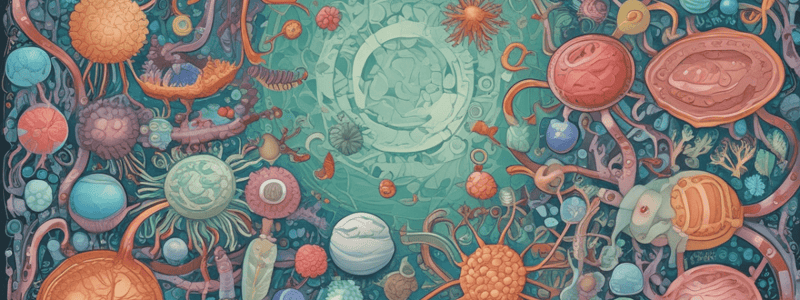Podcast
Questions and Answers
What is the primary function of xylem in vascular tissue of plants?
What is the primary function of xylem in vascular tissue of plants?
- Protection of the plant from external damage
- Transport of nutrients and minerals (correct)
- Production of energy through photosynthesis
- Absorption of water and nutrients from the soil
What is the main difference between plant and animal cells in terms of cell types?
What is the main difference between plant and animal cells in terms of cell types?
- Plant cells are larger than animal cells
- Plant cells have a more complex structure than animal cells
- Plant cells are more diverse than animal cells
- Animal cells are more diverse than plant cells (correct)
What is the function of phloem in vascular tissue of plants?
What is the function of phloem in vascular tissue of plants?
- Production of energy through photosynthesis
- Transport of oxygen and carbon dioxide
- Transport of nutrients and sugars (correct)
- Regulation of water balance in the plant
What is the primary function of muscle tissue in the human body?
What is the primary function of muscle tissue in the human body?
What is the function of dermal tissue in plants?
What is the function of dermal tissue in plants?
The ground tissue system in plants is composed of epidermal cells and parenchyma cells.
The ground tissue system in plants is composed of epidermal cells and parenchyma cells.
Animal cells have a greater diversity of cell types compared to plants.
Animal cells have a greater diversity of cell types compared to plants.
Nervous tissue is responsible for transporting oxygen throughout the body.
Nervous tissue is responsible for transporting oxygen throughout the body.
Xylem and phloem are types of ground tissue in plants.
Xylem and phloem are types of ground tissue in plants.
The human body is composed of only four main types of tissues.
The human body is composed of only four main types of tissues.
How do the three main tissue systems in plants contribute to the specialization of plant cells and the overall complexity of plant life?
How do the three main tissue systems in plants contribute to the specialization of plant cells and the overall complexity of plant life?
What is the significance of the greater diversity of cell types in animals compared to plants?
What is the significance of the greater diversity of cell types in animals compared to plants?
How do the cell types in plants and animals reflect their distinct evolutionary paths?
How do the cell types in plants and animals reflect their distinct evolutionary paths?
What is the importance of the organization of cells into tissues in both plants and animals?
What is the importance of the organization of cells into tissues in both plants and animals?
How do the cell types in plants and animals illustrate the concept of division of labor?
How do the cell types in plants and animals illustrate the concept of division of labor?
Flashcards are hidden until you start studying
Study Notes
Eubacteria and Eukaryotes
- Eubacteria are a large group of organisms that live in various environments, including soil, water, and other organisms.
- They are prokaryotic cells, lacking a nucleus and membrane-bound organelles.
- Eukaryotes are more complex, with a nucleus, cytoplasmic organelles, and a cytoskeleton.
- Eukaryotes are generally larger than prokaryotes and contain membrane-enclosed organelles that provide compartments for different metabolic activities.
Mitochondria and Chloroplast
- Mitochondria are found in almost all eukaryotic cells and are critical for energy metabolism, generating ATP from glucose.
- Chloroplasts are the sites of photosynthesis, only found in plant cells and green algae.
- Mitochondria and chloroplasts are critical for energy metabolism and cellular evolution.
Endosymbiotic Theory
- Eukaryotes developed at least 2.7 billion years ago, following 1.5 billion years of prokaryotic evolution.
- Studies show that archaebacteria and eubacteria are as different from each other as they are from present-day eukaryotes.
- This indicates a divergence of three lines of descent from a common ancestor, giving rise to archaebacteria, eubacteria, and eukaryotes.
- Archaebacterial genes are more similar to eukaryotes than eubacteria, indicating a shared common ancestry.
Plants and Animal Cells
- Plant cells are organized into three main tissue systems: ground tissue, dermal tissue, and vascular tissue.
- Ground tissue consists of parenchyma cells (two types: collenchyma and sclerenchyma).
- Dermal tissue consists of epidermal cells, responsible for protective coat and nutrient absorption.
- Vascular tissue consists of xylem and phloem, responsible for transport of water and nutrients, respectively.
- Animal cells are composed of more than 200 different kinds of cells, with five main types of tissues: epithelial, connective, blood, nervous, and muscle tissue.
Studying That Suits You
Use AI to generate personalized quizzes and flashcards to suit your learning preferences.




